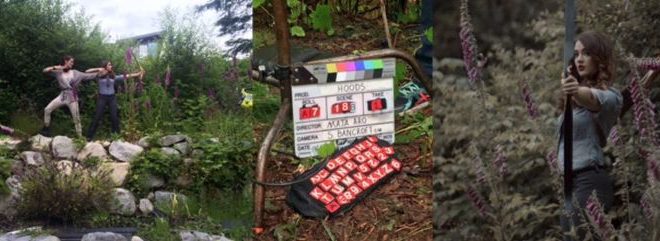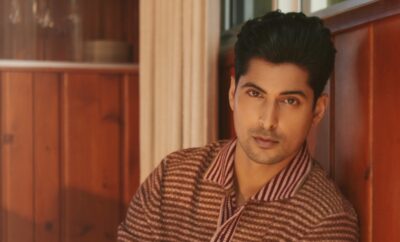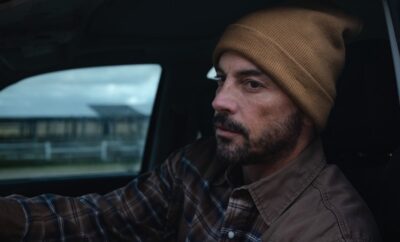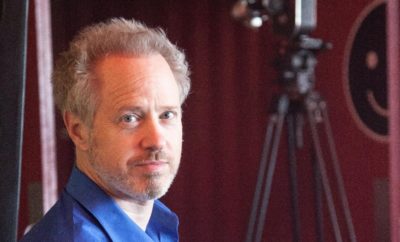 L:Daisy Salvacion Shields Middle:Arianne Robbins R:Screen Grab
L:Daisy Salvacion Shields Middle:Arianne Robbins R:Screen Grab
Interviews
Maja Aro – Hoods
By: Arianne Robbins
Maja Aro has been a professional stunt woman for almost twelve years, best known for her work on the hit ABC television show “Once Upon A Time” (2011) and films Hansel & Gretel: Witch Hunters (2013) and The Cabin in the Woods (2012). This multi-talented individual is also a stunt coordinator, actress, costume designer, writer, producer and production designer. Maja’s wide range of experience in the film industry has lead her to her latest challenge: Hoods.
For Hoods, Aro has shifted gears from stunts, taking the director’s seat in a production of her own creation. Fairytales meet legends as they are transformed into the diesel punk fantasy world of Wolfe occupied Cobalt City. The short film stars Scarlet Hood (Eva Bourne), who in a shocking turn of events must learn the truth about the secrets of her family’s past to carry on the legacy of her grandmother Robyn (Gabrielle Rose).
I had the privilege of being part of the Hoods crew this past June, giving me the opportunity to observe Maja as she guided us forward in the production of the film. Maja Aro is a director with grace and great attention to detail. There’s something special there, in the way her smile lights up her eyes as she goes over the next scene with Eva Bourne, Hoods‘ leading lady. The scene is a heavily emotional one and she approaches it delicately, but with clear intent. As she settles herself behind the monitor, the film crew falls silent in anticipation of what is to follow. She calls “Action!” and turns her full attention to the monitor to watch her vision come to life. Sure enough, it springs directly from the page – reflecting in the tone of the actors’ voices, bouncing off the walls of the warmly lit mechanic’s shop. It’s all there, each piece weaving together seamlessly to create the world Aro has imagined in her head.
I sat down with Maja to learn a bit more about how she’s crafted this world. That excited spark present in her directing returns as she shares about Hoods‘ inception, production and upcoming premiere.
Q) We’re going to go right to the basics of where the idea came from. I know that you have taken characters that we’ve seen in Disney films, that we already have interacted with in our childhood. You’ve taken them and twisted it into something different. Where did you get the idea to twist that?
A) Well, they’re not… I mean, Disney has done versions of some of them, but they’re not really… they’re not Disney characters. They’re fairytales, hundreds of years old. And other legends, like Robin Hood is not even one of those. So, yeah, I’ve taken stories that people are familiar with and I’ve based some of my characters off of that. I’ve based characters off of this whole world…This is just like, a little piece of the pie of the world of Hoods. But really the whole story is there’s multiple characters and this short film is really just the origin story of one of the characters. So, it just gives you a little dusting of what the world is about and a little intro to a couple of the characters that will play in that whole world.
The inspiration for me to create those characters… it originally came from… it actually started from a video game called “Wet.” I was writing this sort of…I wanted to do like a fan film that this character Rubi Malone, sort of badass mercenary…and I was writing stuff like that. It just sort of evolved. I changed her name and I think her name originally was Garnet and then I started basing her more and more off of little red riding hood folklore.
So, I started weaving things into that and then I just started layering and layering and I wrote it last summer. About a year and a half ago, I wrote the original concept. And I think I was working on “Once Upon A Time” and “[The Man In The] High Castle” [laughs] so it’s obviously influenced by what I was surrounded at the time. So, there is a little bit of that sort of military feel from “[The Man In The] High Castle” and that’s sort of why I went with a…you know, sort of a diesel punky theme. I mean it’s not true diesel punk, it’s sort of a fantasy world that has elements of that in it. Like, I love that sort of look.
Q) And it feels like the forties a little bit.
A) Yeah, I mean and that’s definitely from the diesel punk influence. It has that sort of war effort feel. Sort of dark, dirty… kind of looks like it’s of that period. That’s that influence. I really like that look. It’s sort of fun to not have all the technology. It creates lots of opportunities for story, I think. You can’t just get things easily. There’s no instant gratification for anything. You can’t just shoot someone a text. You can’t just look something up on the internet. Your characters actually have to go out and interact with the world and it has that old time feel. I really wanted to have a world that has that. That’s where part of my inspiration came from. I love the aesthetic of diesel punk.
Q) Yeah, you dress like that a lot. It’s great!
A) [laughs] I love some of that and I wanted characters that you kind of feel a little bit…you know they’re familiar, but they’re totally a different version. It’s not something like “Once Upon A Time” where they take the characters and they… you get to see the rest of their story. This [Hoods] is sort of taking those characters and just… you know, using some of the things you know about them, but they’re completely different characters really. They’re just inspired by it, I would say.
Q) So, you decided to take that and then pitch it to the MPPIA. How did that happen?
A) Well, that sort of came about as I was working with someone at the time and we’d done a couple…a project together. We both sort of said that we wanted to do projects so I was like, “Oh cool!” I found that I was always searching for things like how to get funding… like next step, next step. I found the MPPIA and I was like, “Oh! I should submit for this!” [laughs] and I was thinking like we were going to try to write something. I was like, “I kind of wrote this thing like, last month [laughs] and I could polish it and pitch that!” And I was like…you know, I want it to be… I mean it’s a little outside of the box. And I mean it’s for a short film and obviously Hoods I want it to be a TV series. I wanted to start it.
Q) Now that, I did not know! That’s new.
A) Yeah, I want it to be a TV series and I’ve written sort of bibles and loose outlines for multiple seasons of it, hence all the other characters. So, that’s why there’s like… Scarlet’s just one character. There’s sort of three main characters and we haven’t even met the other two yet.
Q) Well I’m excited to meet them!
A) In the bigger world, there’s lots more…lots more going on. So, I wanted to have something that I could pitch as a proof of concept for a TV series. So, essentially that’s what this short film is. It’s that. It’s my proof of concept [laughs] for a TV series, where it’s sort of the origin story of one of the characters. That’s sort of why I wanted to pitch to MPPIA. And then yeah, when I found out I was a finalist I was like, “Okay, I gotta put something really good together!” So, Jeff (my husband) and I went and talked with the people who were working with us at the time and they both uh… quit the project part way through and never took it to completion so we don’t need to mention them! [laughs] I don’t like to slander people… [laughs] It did make the project a lot more difficult, because all of a sudden I was
Q) Because you did Blood as a co-director and you had a bit of a leg up, but with this one it was like, just you! By yourself!
A) Yeah! Which was awesome. I’m really glad I did it by myself. I got to have full creative control and all the creative vision so… because I wrote the story. I mean I didn’t write Blood so I wrote this story and I had such a strong sense creatively of what I wanted to do and how I wanted it to come to life. In the finished product it’s like pretty much exactly how I envisioned it, only a little bit better. So, that I’m happy with. I think having that full creative control, it really does bring the vision that I wanted to bring to life. Yeah, for the pitch Jeff and I threw together a little video and I had to talk, which I hate. In front of like 200 people! And I guess the judges all decided that my project was worth getting behind and funding.
Q) And you literally built it [the set] in your basement.
A) Part of it, yep.
Q) How was that experience?
A) Well I’m tearing it down right now, so that was uh… [sighs] It was fun! It was fun to have a movie set in your basement. Everyone wants to see the set! [laughs] It was kinda goofy! But yeah it was a lot of work to build a set because I’m not a construction person. But artistically I had a clear vision of what I wanted it to look like. You know, I asked some like set painter friends to help with different texturing techniques. And you know I just… did that with lots of spray bottles and added texture and drips and just made it look as shitty as possible, which it was supposed to.
Q) Which was definitely a success.
A) Yeah, I think it reads really well on camera. I think that set in particular has a lot of life. The sets that we rented, the sets we rented for the days… I think a lot of those had a lot of texture. I mean we had… I think it was… We used Brock Whittaker and Eva Maurice’s mechanic shop for a day. It was the stuff that was already in there that we dressed in some of our own set dressing, but a lot of that stuff is just their things that were already there! [laughs]
Q) Convenient!
A) Yeah! So having that… that was really awesome of them to let us rent their space. They even had an old car that they dragged in to let us use. It’s just things that you don’t get easily, especially in a period film to get that many things.
Q) You had a lot of cool picture vehicles and a lot of interesting props behind the scenes that we maybe didn’t get to see a whole lot of?
A) Yeah, I mean one of my friends, Clint, he owns Space Lab in Gastown and he lent us a lot of props. Like a lot of really cool antiques, that we sort of laced in and found things from the period even things that were kinda even pre that period. We laced ’em in and kind of gave more life to that fantasy world. That’s what I pitched to MPPIA. I pitched that I was gonna create a world. So, I had to commit to doing that. I think with the help of everybody that came out, I think we were able to achieve that. I think it definitely doesn’t look like it’s of this period. Definitely there’s familiarity to it, but it’s not too weird. It’s not like a full on sci-fi. But, you know there’s like slightly odd elements. Like even some of the costumes are not straight out of the 40’s. I think there’s a bit more of a twist to some of them. So, it’s not like you’re specifically in that era. You’re in a new world, which was the aesthetic I wanted to have.
Q) It’s like we recognize pieces of that period, that feel familiar to us. It’s really interesting… like you were saying about the military influence. That was really present in the costumes, which I thought was really interesting from my time there [on set]. I liked that a lot.
A) Yeah, I wanted it to feel like there was definitely a very big military influence.
Q) What about the music?
A) Ahh the music! [laughs] I’m super excited about the music. We’ve got two songs from Arches, a band out of LA. And then my friend Matt Bergeron.. he actually composed the entire score. The end credit score he wrote custom made for the film. I’m quite excited about the music. The music is really, really cool.
Q) So, the post production process! You’ve been spending a lot of time in meetings and with your people putting it all together?
A) Well, not so much meetings. But I’ve spent a lot of time doing stuff. Jeff edited it so he and I have spent a lot of time going over it, watching it, cutting and cutting and piecing it together. And then Final Post did all the coloring. And yeah all the music came together… Peter Mulholland did post sound… Gregor Phillips did the Gibson sound mix. We had a lot of really… yeah tons of people worked on it! So, I’ve little bits here, bits there with everybody doing stuff. But finally getting the full picture locked then getting it colored, every little step it just becomes more and more of a tight package. Like layering in the final scoring, we did the final sound mix and then we like, did the final sound scoring and now it’s a movie!
Q) And it’s more of a world than Blood was, so you really had a lot more to consider when you’re cutting the scenes and figuring out which ones fit.
A) Blood took place in one location and it was a period film as well. But it was a straight up period film so there was no artistic veering from what that needed to look like. And it was shot, again, in one location, in one day.
Q) What were the challenges going from something like that to Hoods would you say?
A) I mean, everything was bigger. Everything was on a bigger scale. Bigger budget, bigger crew, more actors… lots more actors. We had extras one day, we had a lot of props, we had picture cars, we just had lots more. We had a bigger crew and we only had a skeleton crew for Blood. Just the logistics of where are people going to park and where are we going to set up lunch? Just the little logistics like that made it more challenging. But as far as creating the film because of the world we were creating and artistically what I put into Hoods it was challenging. I think the fun outweighed the challenge so much [laughs] so it was a lot more thrilling for me. I mean [laughs] as much as it was more challenging just logistically, we shot in the forest, we shot in like six different locations. So, all those logistic things were a bigger challenge, but I think the creativity and the artistic input that I had put into this made it way more fun!
Q) What will you take from Hoods to apply to your next project?
A) What I would take away from this is that I should really trust my gut. And that I do, I guess, know what I’m doing a lot more than I think I do. I still have tons to learn but you know, my gut and my instincts as an artist I think work for me. So, I think I just need to trust that. And just picking and choosing who I work with. I think that was a big one on this, a big life lesson. [laughs] So, that would be a big one to learn. You know, really be careful and I’m almost too trusting sometimes I think. I need to make sure that I’m not as trusting, especially with my art. And then just technical lessons, like you’re always gonna learn those! [laughs] Like, you know if your next film is not better than your last one you’re doing something wrong. Technically, obviously I learned a ton. I was way more hands on with this film. You know, prep to shooting to post. I really got to be involved with every step of that process quite intimately. So, that taught me a ton about filmmaking. I’d be right in there with so many different departments. And to communicate my vision clearly to all those departments, I think I was able to do that. The end product is proof of that. It’s what imagined in my head so I think I was able to do that. So, I think working with everybody and being able to communicate that worked out. It’s much more of a competence thing that I learned that you’re like, “Okay! That’s right! Okay!” That’s definitely something I learned. All those things I would take into my next film and make it better. Even little things about my writing. I think the biggest one for me is like, I didn’t necessarily write a lot of transitions into the script. In my next film I need to write better transitions. Who told me? I think it was Liz Levine who told me, “If it’s not on the page, it’s not gonna come out when they film it.” And it’s so true! If it’s not there, even though you know I wrote it… When you’re there on the day, you’re not necessarily shooting those extra little bits because they’re not on the page. So, I mean you have to put them on the page if you want them to come out on screen.
Q) Just because you see it, doesn’t mean everyone else is going to.
A) Yeah! I mean, if you’re directing your own thing that you wrote, you’re not necessarily catching those little shots that might help you transition. So, that was one thing that I would take forward.
Q) What advice do you have for someone who is seeking to do what you’re doing? Taking your vision, making it a reality and bringing it forward into something as big as a series proposal?
A) You kinda just have to do it. [laughs] You can’t just sit back there and be like “Oh, maybe someday.” If you don’t just jump out and do it, you’re never going to do it. At some point you have to take the first step. And even if you have a project that’s kinda your baby, maybe start on something else. If this one’s so near and dear to you, keep that one for later and do something else. But at least do something! If you never do anything, you’re never gonna progress and you’re never gonna… Like, I don’t like speaking in public. [laughs] But I want to be a director. So, I got over that and spoke in public. You find ways that you can get funding. There’s so many right now. There’s Storyhive. There’s Telefilm. There’s so many different things from different film festivals that you can enter to get funding. Even if you’re starting on your writing project there’s screenwriting mentorships that you can get just to… at least then you’re starting to do something. So I would you say you really just have to do it. Like, I’ve been a professional stunt performer for almost twelve years. I could just keep doing that. [laughs] I have a great career, but I want to be really challenged. So, by taking the step into something else you have to take that step into the fearful unknown at some point or you’re never going to.
Q) If you’re nervous about it, it means it matters to you.
A) Yeah! And you could stay in your comfort zone forever, but then you’re never gonna get out of your comfort zone. You’re never gonna achieve higher than that ceiling that’s your comfort zone. If you want to do something like that, you have to just be bold and do it. You might feel like “Oh this might scare me,” but [laughs] I’m gonna do it anyways!
Q) Obviously, it was worth it for you because this is going to be an awesome premiere!
As winner of the MPPIA grant at Whistler Film Festival 2015, Hoods will premiere at The Whistler Film Festival on December 3rd during the “Shortwork Three” showing at 10:00am and December 4th during the “Big Rock Shortwork Showcase” showing at 4:30pm.
Stay connected with Hoods online!
Facebook: https://www.facebook.com/Hoods1918/
Twitter: https://twitter.com/hoods1918





You must be logged in to post a comment Login